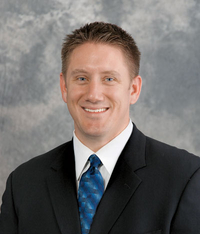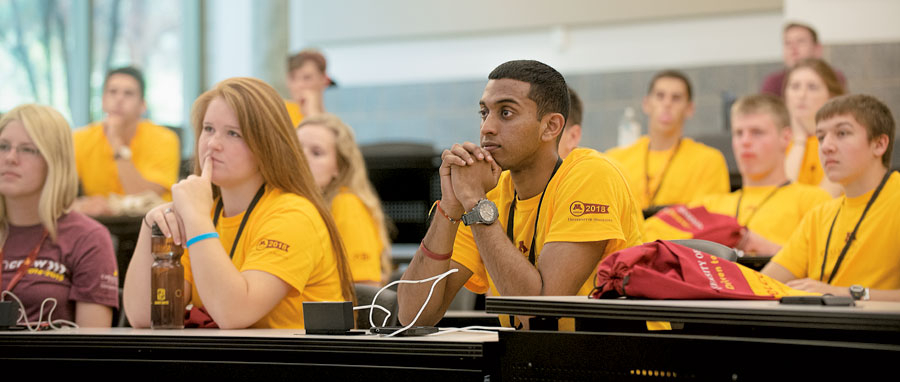
The Student Experience
Tuesday, November 25, 2014
The Carlson School currently serves about 1,584 MBA students. There are 389 individuals enrolled in our other graduate programs (MAcc, MBT, MA-HRIR, and the new Master of Science in Business Analytics). We have 96 PhD students. And, our four-year undergraduate program is inching toward 2,500 students—the incoming class of 545 freshmen is our largest yet.
Although each one of these students has his or her own unique background and story to tell, they are all united in their desire to be a part of the Carlson School family; to join the nearly 53,000 alumni who have passed through our doors in our 95 years of existence.
Today's students desire both personal and professional fulfillment
But what is it like to be a Carlson School student today? How do they view the world—especially the business world—compared to previous generations of students? What are their goals and desires? How have technology and teaching styles adapted to meet their needs?
Mindy Deardurff, the director of the Undergraduate Business Career Center, finds that today’s students provide schools with an interesting challenge, in that they desire both personal and professional fulfillment.
“A great example is that in the Millennials in the Workforce Report published by the Bentley University’s Center for Women and Business, 84 percent say that making a difference in the world is more important than professional recognition,” she says. “Sixty-five percent say that being successful in a high-paying career or profession is either very important or one of the most important things in life.”
Today’s students also tend to be high achievers who want to find or build community. They want to travel, be given challenging assignments, and have the opportunity for a flexible work environment. More importantly, they want their work to have meaning.
“When we say ‘meaningful,’ that definition varies from student to student, but the bottom line is students want to feel good about what they do,” says Graduate Business Career Center (GBCC) Director Maggie Tomas.
Sometimes this translates into social venture and nonprofit work, but often it is believing in the values of the Fortune 500 company they work for. In terms of impact, students want a role that allows their work to be noticed and have value toward company decisions.
“We have seen an increase in students pursuing entrepreneurial or start-up work that offers clear impact or working for organizations that can prove they have a start-up/entrepreneurial culture,” Tomas says. “Do students still seek stability, work/life balance, and competitive salaries? Yes, but they also realize that nothing is forever, jobs come and go, and work/life balance is often an unachievable myth. So instead, they focus on finding roles that put them on a path toward a career that is interesting, autonomous, and full of options for any stage of their life.”
Tomas says the GBCC repeatedly hears from recruiters who are looking for students who are entrepreneurial, creative, think outside of the box, and are often scrappy in their approach.
“Employers still want leaders who have executive presence and can work autonomously, but they also want business leaders who are not afraid to offer a different view,” she says.
Searching for tomorrow's leaders
For nearly eight years, Nick Koewler has been recruiting at the Carlson School for Land O’Lakes, Inc. As the talent acquisition manager for college relations, he has oversight of the recruiting activities that focus on intern and entry-level hiring across Land O’Lakes as well as its federated co-op system.
“I look for students who strike me right away as future leaders—students who have good communication skills and show a passion around the work they are doing,” he says. “We talk a lot about finding students who have the intellectual curiosity to not only produce high-quality work but also to take that work to the next level. These students typically have the great work ethic and teamwork skills that tie into the culture we have at Land O’Lakes.”
Over the years, Koewler has definitely seen a difference in students, not only in their abilities, but also their thoughts on careers. “They are more resourceful in terms of utilizing all the tools they have available to find the right answer,” he says. “With their accessibility to use technology in their personal lives, they definitely have a higher ability to pick up new technologies at work. I also think the students of today have an eye on the ‘what’s next.’ They want to learn about everything and be better cross trained on every aspect of a company or organization. They want to become well rounded and have various experiences along their career path; that ties in well to a lot of companies’ rotational positions upon graduation.”
Dan Stangler, ’05 MBA, is the associate director of marketing for Old El Paso at General Mills, Inc. and also heads up its Carlson School marketing recruiting efforts. He recruits, interviews, and manages associate marketing managers. In the 10 years he has been with General Mills he has consistently observed three key things: MBA graduates want to be at a place where they can lead and make a difference, they want the opportunity to develop, and they want to feel valued. “We strive to provide an environment where employees can match their strengths and interests with business needs. Carlson School graduates consistently bring a powerful combination of business fundamentals, creative and critical thinking, and a collaborative approach that’s a great fit for General Mills’ culture,” he says.
Stangler says technology use has created a powerful and unprecedented expectation of empowered career ownership—both control and customization. “It’s created a critical need for the school and employers to ensure their future leaders are prepared to successfully own their career path and corresponding responsibilities and business results in this fast and ever-changing environment,” he says. “This also has changed how students learn, make decisions, and take action appropriately across stakeholder groups while they’re at the Carlson School and once they’re into their careers.”
In the classroom
In his 34 years of teaching in Minnesota, Professor Tim Nantell has seen many changes in student character as classes come and go. “Today’s generation of students is challenged with many more responsibilities than was the case for students when I started teaching,” he says. “They now worry about networking from day one, not to mention community service, developing leadership skills, and honing written and spoken communication skills. There is good and bad in every contract—all of these ‘outside’ interests and responsibilities mean they sometimes pay less attention to their classes than used to be the case.”
Professor Steve Huchendorf, who goes by Dr. H (he says, as an economist, he is all about efficiency), teaches in both the undergraduate and MBA programs. He notes many students are further ahead in their lives than students in the past. “Undergraduate students are arriving with more college credits already completed through high school programs such as Advanced Placement and International Baccalaureate,” he says. “This allows students to free up credits for general education and explore different areas.”
Being so far ahead in their studies means students are also a bit further along in their choice of majors and careers. “I see a few more students today that come into the Carlson School having made up their minds that they are going to pursue a specific major,” he says. “More students have a background with foreign languages and are interested in global studies and international travel.” Dr. H jokes that he finds the millennial generation is quite comfortable with multitasking as well, especially texting, whether it’s in class, while walking, driving, riding a bike, eating, etc.
“The world for business students has become much more competitive,” Nantell says. “It’s obvious in just the number of students who graduate every year; the explosion in those numbers exceeds the growth in job opportunities. One of the changes this brings to students’ perspective is that they are just laser-focused on job opportunities from the first day.”
Interestingly, Nantell hasn’t noticed that students’ attitudes about business have changed very much, other than a revving up of competition in certain career paths. “Since 2008, there is a distinctive shift away from interest in financial service industry jobs,” he says. “They do not have the same pull they had pre-2008.” In the past few years, Dr. H has noticed increased student interest in supply chain, international business, nonprofits, environmental concerns, corporate social responsibility, and ethics.
Technology plays a huge part in today’s academic experience, extending beyond the classroom. “We can provide a chain of learning experiences with learning activities before the class session, during the class session, and after the class session,” Dr. H says. “Technology has facilitated the development of learning experiences in the chain, including shifting the knowledge/comprehension levels of learning to before the class session. With students having already read the chapter and taken a quiz on definitions, I can now help out with the higher levels of learning during the class sessions.” Students now work on higher levels of learning of “apply and analyze” during the class and “evaluate and synthesize” after the class session.
Nantell, who has taught corporate finance for most of his years as a professor, has also noticed that it takes a lot more ingenuity in the classroom to successfully promote a genuine curiosity about basic financial ideas and principles and approaches to thinking about finance that will serve the students throughout their careers. “Sometimes the current topics take precedence over the more fundamental ones,” he says. “On the other hand, this has probably been the professor’s lament forever.”
In order to do more to promote basic curiosity regarding fundamental ideas in his finance classes, Nantell says he has gone almost completely to a flipped classroom. “This means I am asking students to not only read but also to try to do things before they come to class,” he says. “I know they won’t be able to do or understand everything I put on their plates. Class is then the chance for the Q&A that helps them figure it out. This puts much more responsibility on the student to come to class ready to jump in. It is sometimes difficult to get everyone, from all different kinds of cultures around the world, to buy into this classroom style.”
For the future, Nantell expects more and more classes to move to videos online before scheduled class meetings. Classes will be exclusively for sorting out the issues that students find confusing and for discussions in general. “I think this is great for what everyone says is central for higher education—teaching students how to think critically,” he says. “It frankly moves significant responsibility from professor to student—no longer can students sit and listen and write. They have to do the work before they come to class, scratch their heads over what isn’t clear, and then be aggressive in class, getting the answers they need. I think, and hope, it also ups the level of conversation from filling in the formulas to understanding the principles behind the formulas.”


